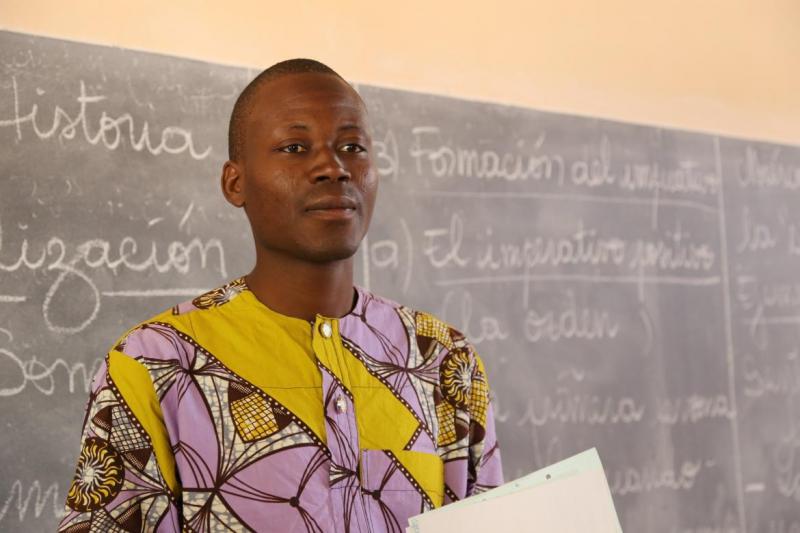
Good teachers and effective teaching inspired by the best leadership are the heart of the learning process and the single most important school-based factor for improving learning and equity in education outcomes. This is why teaching and learning is a priority area for GPE and therefore the Results Report 2019 shows that 70% of GPE partner developing countries, mostly in sub-Saharan Africa, still have more than 40 students per trained teacher at this level.
Findings from GPE’s evaluations in selected countries indicate that teacher training has been strengthened in many countries, but concerns remain with its quality and the variation in what constitutes a trained teacher.
Indicator 11 of the GPE results framework tracks the equity of teacher allocation. The Results Report 2019 shows teacher allocation is inequitable and inefficient in most of the partner countries where there is data. In addition, the best teachers are not where they are needed the most: helping marginalized students match the learning outcomes of their peers.
The neediest populations remain underserved, and many countries struggle to attract enough effective teachers to rural areas. GPE’s country-level evaluations indicate that more focused efforts are needed in this area.
KIX prioritizes teachers and teaching
The evidence on what works to improve teaching and learning and models for effective classroom practices is growing, but there is a need for more support for developing countries to extend this research, adapt it and apply it appropriately to specific contexts and at scale.
The Improving Teaching and Learning maps challenges and existing global public goods, highlighting gaps and opportunities. Six areas of potential investments are detailed:
1. Improving teacher and teaching data and its use
Different types of qualitative and quantitative data on teachers are provided by a range of global and national institutions. Investments through KIX could support collating and aggregating the data provided by different organizations for each of the partner countries and explore demand for additional country-level data for understanding teacher and teaching quality issues.
2. Supporting teacher recruitment, selection and retention
There are education systems where recruitment and selection practices could be strengthened to increase accountability and transparency and improve the quality of teachers recruited. Some partner countries have designed and implemented interventions that result in merit-based selection of teachers, which could be evaluated to identify and share practices that attract and retain the teachers who teach most effectively. There is also potential to develop innovative solutions to use effective leaders and teachers differently and more effectively in contexts where there is high-teacher shortage (including in fragile and conflict-affected areas).
3. Supporting teacher accountability, incentives and rewards
Sharing of practices for expanding professionalism and motivating teachers at scale along with a review of current evidence could be supported through KIX. Additionally, there is potential to identify or pilot innovative solutions to address issues related to accountability, incentives and rewards.
4. Supporting teacher preparation and professional learning
Low levels of subject-specific knowledge and effective pedagogy are areas where teachers require support in most partner countries. The evidence for what works at scale to rapidly improve subject knowledge and how to support teachers effectively to improve classroom practice is growing. The challenge is now how to implement effective models of teacher professional learning at scale and monitor the impact they have on learning.
5. Supporting enabling school and system factors for effective teaching
School-based factors, including culture and leadership, are key elements in facilitating effective teaching. In low resource contexts some partner countries have managed to work on these factors and others could benefit from the transfer of knowledge and practices that work. With regards to teacher development, school-based solutions have been tried in different contexts, with room for more innovation. This would be an important area of study, especially for investing in sustainable models for teacher development.
6. Supporting finance, planning and deployment
Investment through KIX could learn from countries that have designed and implemented interventions to address technical and political barriers. With deployment of teachers in areas where they are needed the most remaining a persistent challenge, there is a need to explore solutions and innovations that sustainably attract, incentivize and retain the best teachers to the locations and grades where they are needed the most.
As the proposals for the KIX global call are submitted by October 1st - and the regional grant proposals in April/May 2020 – it will be exciting to see how KIX investments provide opportunities for tangible capacity development, research support, and innovative practices to help countries improve the quality of teaching and effectiveness of teachers.
Additionally, the KIX Regional Hubs will provide an opportunity for countries to learn from their peers on innovative approaches that have improved teaching standards and accelerated students’ progress in learning.
Read the other blogs in this series:
